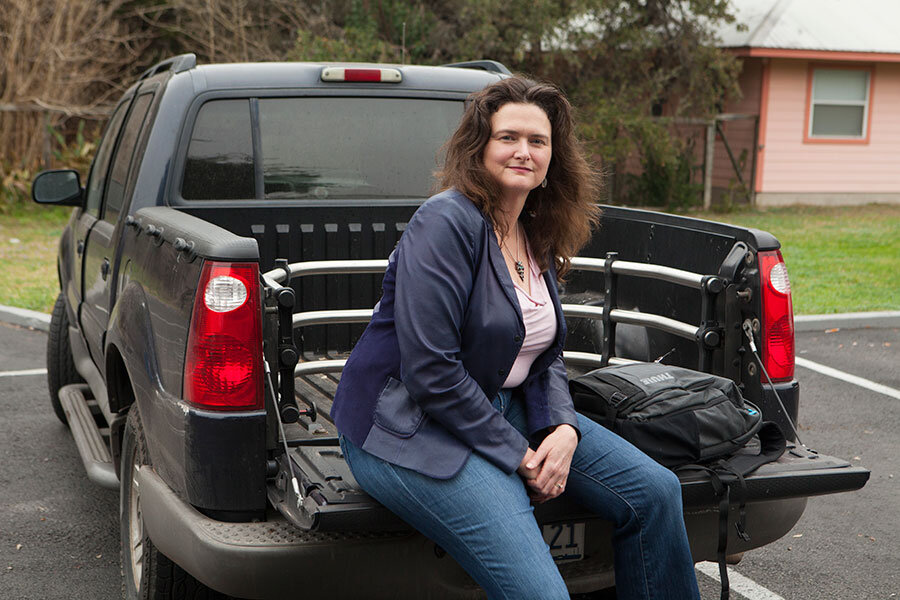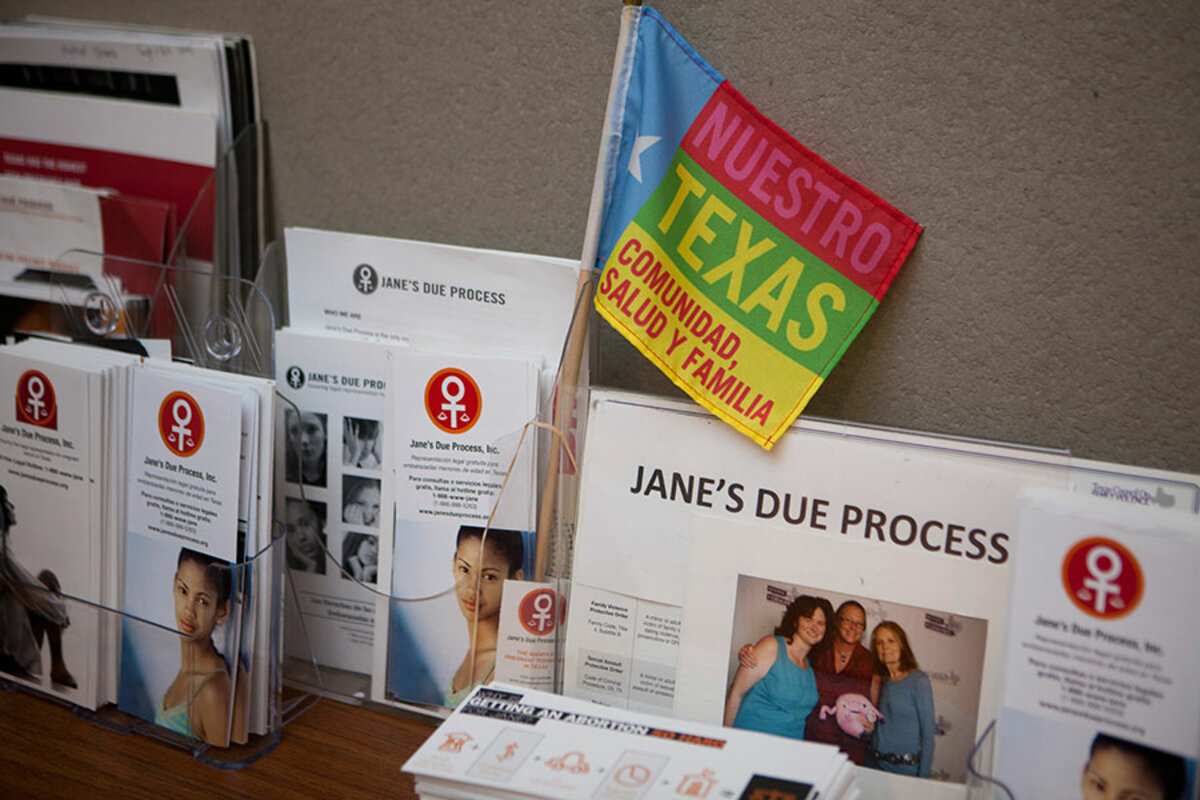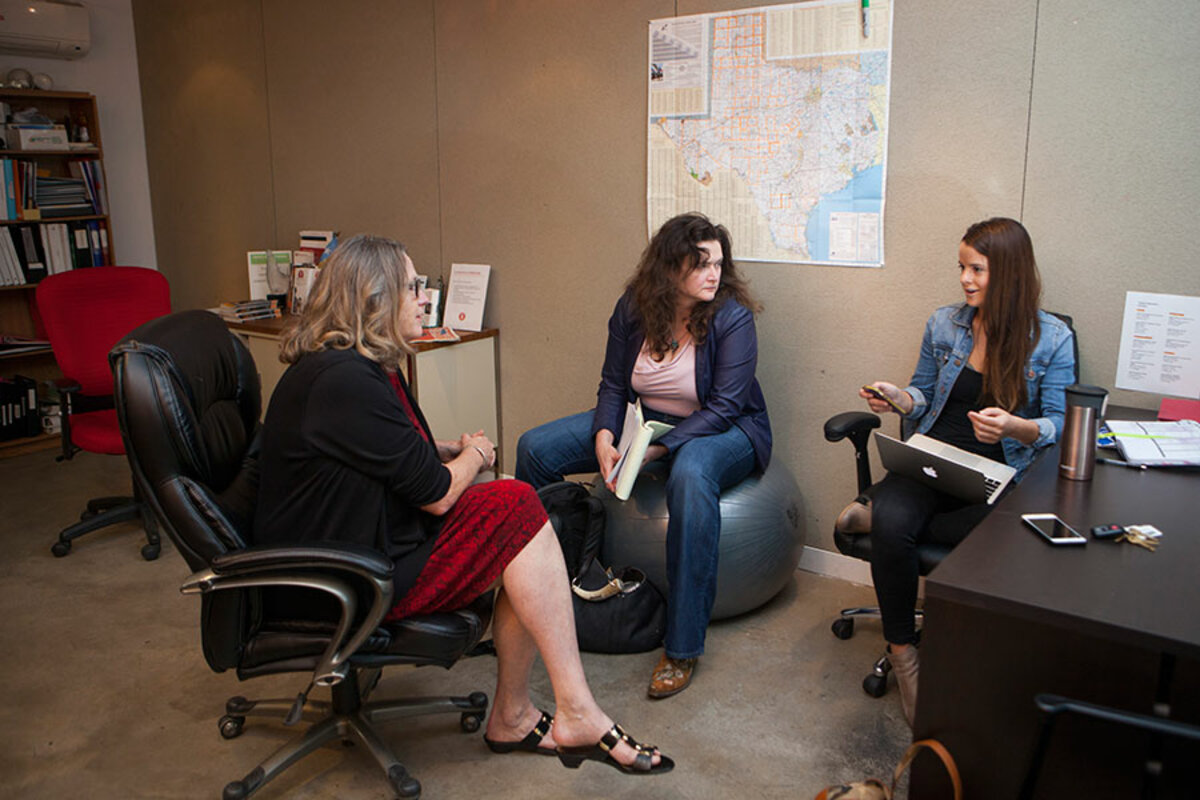In Texas, a side of abortion debate few ever see
Loading...
Since 2011, the Texas Legislature has passed a series of laws that make it more difficult for women to obtain an abortion. The Republican-controlled legislature is shifting government money away from abortion clinics and enacting new measures that, supporters say, make abortions safer. Critics say they only complicate the process.
On Wednesday, the United States Supreme Court will examine whether one of those laws violates constitutional protections. With the high court showdown looming, the Monitor went to Texas to examine what these restrictions mean for Texas women.
This is the first of a three-part series. Read Part 2 here and Part 3 here.
AUSTIN, TEXAS – The high school student was 15 when she discovered she was pregnant. She stared down at the home pregnancy test, then at her boyfriend, then back at the test.
Her mind raced to comprehend the magnitude of her dilemma. What would she do? What would she tell her parents?
“I knew the moment my parents found out I was pregnant they would force me to have the baby,” she said in a recent interview.
The Texas teen, now a sophomore in college, spoke to the Monitor on condition of anonymity. Her parents, who are deeply religious, know nothing of her abortion.
She agreed to tell her story in advance of what could become a landmark US Supreme Court case – potentially the most important abortion decision in a generation. The high court is set to hear the case on Wednesday.
At issue is the constitutionality of a Texas law – House Bill 2 – that has forced the closure of roughly half the abortion clinics in Texas, making it more difficult for women in the state to obtain an abortion.
A key question is whether the law poses an undue burden on a woman’s constitutional right to end her pregnancy.
For some Texas women, it is merely an inconvenience. For others, who can’t take time off work or travel long distances, the new restrictions are more problematic. But for still others – like a frightened 15-year-old high school student – the new restrictions may make abortion an impossibility.
The 15-year-old’s unwanted pregnancy was detected shortly before passage of HB2. Now, after HB2, it has become significantly more difficult for teens in her shoes, experts say.
This is a side of the abortion debate in Texas that few ever see up close. It is a story of despair, of struggle, but ultimately of hope. This is their story – the story of a nameless, faceless group of girls and young teens who are called simply “the Janes.”
Three types of women are likely to face the most severe obstacles as a result of HB2, say experts who have studied women’s health services in Texas. They are women in poverty, women living in rural areas, and teenagers.
In many cases, these experts say, pregnant teens fulfill all three of those criteria – they are poor, they are rural, and they are young.
“Texas does nothing for teenage girls. The Janes are the least among us,” says Susan Hays, a Texas appellate lawyer and legal director of a group called Jane’s Due Process (JDP).
An unmarked, one-room office
Thirty-eight states including Texas require parental notification or consent before a daughter 17 or younger can receive an abortion. But all 38 states also have their own judicial bypass procedure around the parental consent requirement.
Texas law allows a bypass when parental involvement is either impossible or might pose risks to the teen.
JDP operates a 24-hour hotline, a website, and a statewide e-mail list of volunteer lawyers willing to represent teens needing help with a bypass. It is the only organization of its kind in the US.
Ms. Hays helped establish the non-profit group 15 years ago. It is run on a shoestring budget with a three-person staff in an unmarked one-room office south of Austin.
They refer to their clients as “the Janes,” for the anonymous “Jane Doe” that they list on confidential court documents to keep the proceedings secret and to protect their clients’ privacy.
Even with the teen standing before the judge, her lawyer refers to the teen as “Jane” so no identifying reference will find its way into the court record or the transcript of the proceedings.
In conservative Texas, JDP’s activities have been controversial, with some parents complaining that the bypass provision infringes their parental right to raise their daughters in accordance with their religious beliefs and their own best judgment.
“My daughter can’t go to a tanning bed without my consent if she is under the age of 18, she can’t get her ears pierced, yet she can go and lie on an abortion clinic table… without parental involvement,” says Abby Johnson, a former abortion clinic director turned antiabortion activist.
“Parents should have a veto,” Ms. Johnson says. “Absolutely, I think parents should be able to veto a child’s decision when it comes to something that serious.”
Supporters of judicial bypass procedures emphasize that Supreme Court case law mandates that the ultimate decision belongs to the pregnant teen – not her parents.
To receive a bypass a teen must demonstrate she is mature and well informed about her pregnancy options. Alternatively, she must show a judge that the desired abortion would be in her best interest.
The judge is not granting permission for a daughter to end her pregnancy. Instead, the process is designed to clear away outside influences and any potential coercion to allow the teen the space needed to decide for herself.
To be sure, most choose an abortion. But not all do, according to Tina Hester, JDP executive director.
“We have refugees [in Texas] who are immigrants from Nicaragua and El Salvador. We had one recently call us, she turned out to be 18 weeks [into her pregnancy], and after she saw the sonogram she couldn’t have the procedure. It was just too traumatic to have an abortion,” Ms. Hester said. “I think she was 15.”
When a teen decides she will continue the pregnancy, JDP puts her in touch with services that provide prenatal care.
“We don’t say, ‘Oh, you aren’t going to have an abortion, don’t call back,’ ” Hester says. “No. It’s her decision. That’s the whole point.”
'That kid was certain'
Those who find their way to JDP are a very small segment of pregnant teens in Texas. Statistics show that 9 out of 10 pregnant girls do tell their parents and seek their parents’ help and advice during an unplanned pregnancy.
There were 63,800 abortions performed in Texas in 2013, the last year for which state statistics are available. In that same year, 2,175 abortions were performed on teens 17 and younger. Of those, 181 teens were referred to a lawyer for a judicial bypass with the help of JDP.
The reasons justifying those bypasses vary from rape and severe abuse to threats of violence and other coercive behavior by parents. One common form of parental abuse is: “If you ever get pregnant outside marriage we will throw you out on the street, you will be on your own.”
Some seeking a bypass are already moms caring for one or more children and feel they can’t take on another child.
In other cases, parents are not available to give their consent; they are dead, in prison, working far away, serving in the military, or too strung out on drugs.
In a friend-of-the-court brief filed in the Supreme Court case, Ms. Hays recounts how she obtained a judicial bypass for a pregnant fifth-grader. The girl had just turned 12.
She was the youngest of four daughters of a single mom. The mom had a live-in boyfriend, who at some point began raping the fifth-grader. He warned the young girl that if she told anyone about the sexual abuse he would hurt her mother. So the girl endured the abuse in silence, until her older sister noticed a bruise and took her to the emergency room.
Doctors discovered she was 17 weeks pregnant.
Investigators weren’t sure whether the mother was complicit in the abuse. The 12-year-old was placed temporarily with a family friend, complicating the legal issue surrounding parental consent to an abortion.
JDP went ahead with the bypass process to ensure the procedure could be done before the 20-week cutoff for an abortion in Texas. During a counseling session with her doctor, the girl was told the full range of her options, including giving birth to her rapist’s child. Hays says the 12-year-old never wavered.
“She explained that her big sister had had a baby and her quote was, ‘I don’t want to have a baby – it hurts. And besides, I don’t even like kids,’ ” Hays recalls the girl saying.
“That kid was certain,” Hays says. “How traumatic would it be to force her to go through that and force her to spend the rest of her life thinking about that child?”
Although the vast majority of JDP actions are conducted in a confidential setting in a judge’s chambers without the knowledge of the teen’s parents, there have been a few cases where parents have tried to legally intervene to prevent a daughter from getting an abortion.
Allan Parker, president of the antiabortion Justice Foundation in San Antonio, said he represented parents in such a case. “The girl came to them and said, ‘I’m going to get an abortion and I need your permission and if you don’t give me your permission I’m going to get a judicial bypass,’ ” he says.
“We attempted to intervene so the parents could at least present their side to the judge, but we were unsuccessful,” he says.
At its most basic, the issue is whether parents or a judge can force a teen to carry her pregnancy to term and give birth against her will.
The flip side of that same argument applies to parents who try to coerce their daughter into having an abortion she doesn’t want.
“Parents are entitled to have an opinion but they cannot unduly force or coerce their daughter with threats like ‘I’ll kick you out of my house,’ ” Mr. Parker says.
“Legally, if she says I don’t want this abortion, the parents can’t stop [that decision],” he says. “It is the woman’s right to make the decision for reproductive choice whether she wants an abortion or wants to give the child life.”
What Texas has done
The current Supreme Court case is examining HB2 and its requirements that abortion clinic doctors obtain admitting privileges at a local hospital and that such clinics maintain the standards of an ambulatory surgical center.
Some hospitals in Texas refuse to grant admitting privileges to doctors who perform abortions, and it can cost $1.7 million to $2.6 million to expand and upgrade existing clinics to ASC standards.
Those two requirements have forced a large number of abortion clinics to close. Before HB2 there were 42 abortion clinics in Texas. After the law took effect, that number dropped to 19. Should HB2 be upheld by the high court and fully enforced only 10 abortion facilities would remain in Texas, the second largest state in the US in both area and population.
Hays says it is necessary to consider the full sweep of antiabortion legislation passed in Texas in recent years, not just HB2. “For any individual you don’t know which of the dozens of regulations are going to be an insurmountable obstacle,” she says.
Last year, the Texas Legislature enacted new restrictions designed to make it harder for teenagers to obtain a judicial bypass. The restrictions, which took effect Jan. 1, impose a higher standard of evidence for a judge. They require a teen living in a county with more than 10,000 residents to file the bypass action in her home county, even though that could compromise the confidentiality of the process.
Perhaps most important, under the long-established bypass regime a judge was required to rule on each case within two days. A failure to rule in two days was deemed an approval of the bypass. Now a judge has five days to rule and failure to issue a decision within that timeframe is deemed a denial of the bypass.
The bottom line is that each new regulation has substantially complicated the basic logistics of getting an abortion in Texas, JDP officials say.
For example, the reduction in the number of clinics has caused long wait times at a few of the remaining clinics. In the Dallas-Fort Worth area there have been periods when it can take as long as three weeks to get an appointment.
That’s only part of it. Texas law requires that all women seeking an abortion undertake a sonogram and a counseling session at least 24 hours before the procedure. That means that an abortion requires two appointments and two trips to the same clinic. The judicial bypass proceeding in court for a juvenile adds a potential third appointment and third trip.
The detrimental effects of Texas regulations are amplified for minors, says Emily Rooke-Ley, JDP’s director of client services who manages the group’s hotline.
“For girls it is all those obstacles that everybody else is facing, on top of how do they skip high school? Who has a car? Who has a driver’s license? I don’t want to put a 15-year-old on a bus at night going two and half hours away.”
Six hundred miles
When it started, JDP’s role was fairly limited. Someone would call the hotline and the group would arrange a volunteer lawyer to handle a bypass case.
Now, after HB2 and other laws, Ms. Rooke-Ley has become a 24/7 case manager for the 20 or so pregnant teens she is marshaling through the system at any one time.
Finding a lawyer is the easy part. After that, Rooke-Ley is busy helping to arrange appointments, trying to find money to help pay for the procedure, and working to solve transportation issues. She is also sensitive to the fact that most of the girls who call the hotline are at levels of desperation unprecedented in their young lives.
“I start every single phone call by saying don’t do anything rash,” Rooke-Ley says. “I am going to help you,” she says she tells each caller. “If you panic any time of day or night you call me or you text me, like I’ve got your back here. And let’s take care of this safely and responsibly.”
Rooke-Ley remembers one client in particular. She lived two hours from the nearest clinic but had no way to get there. “She had absolutely no support system. She was terrified already,” the hotline coordinator said.
“She took a Greyhound [bus] and made it to the clinic [for her initial consultation and sonogram], but when she got out it was dark outside. She called me from the side of the highway. She said: ‘I’ve never been in a city before, I don’t know how to get a taxi to the Greyhound station to take the bus back [home]. So I tried to walk there, but now I’m lost.’ “
“She was crying. It was horrible.” Eventually she found her way to the bus station and got home after midnight. “God knows what her parents thought,” Rooke-Ley said.
“I wish I could have gone and given her a safe ride, but the girls are spread all over the state.”
To get an idea of the distances involved, it is a 600 mile drive between Fort Worth and El Paso. All the clinics that once operated in the vast area between those two cities are now closed.
In JDP’s office, Hester points to a wall map of Texas. She runs her hand west toward El Paso. “This just scares the heck out of me,” she says, motioning toward west Texas. “Imagine somebody trying to traverse that. So that’s what happened after HB2.”
She says if the Supreme Court upholds HB2, wait times at abortion clinics will increase dramatically.
“It would be a disaster,” she says. “It would force minors into second trimester procedures which then limit their options because they can’t come up with the funding and it is a riskier procedure.”
An abortion gets more expensive and more invasive the longer one waits to have the procedure. Thus, long wait times at a clinic can not only result in a more traumatic experience but literally price someone out of an abortion.
According to rough estimates, a first trimester abortion can cost roughly $525. An abortion at 17 weeks might be $1,000 or more.
Rooke-Ley says she asks the girls if they have money to pay for the procedure, as well as to cover food and transportation costs.
“They say I’m working on a college fund, so I can take it out of that,” she says. “That just breaks my heart.”
Desperate for help
Several groups have formed to help provide transportation to and from clinics. Other groups, such as the Lilith Fund, can provide vouchers to help low-income women and teens pay for an abortion.
In one of her cases, Rita Lucido, a Houston lawyer and a member of JDP’s legal advisory board, said she represented a 17-year-old who wanted an abortion.
When she was 15, the girl was raped and impregnated by her mother’s boyfriend. The boyfriend was convicted and sent to prison and the girl got an abortion. The girl’s mother talked openly and dismissively with others about the crime.
“This child’s greatest sorrow was that the mother announced to the rest of the relatives and to the community that the 15-year-old had [slept with] her boyfriend and got pregnant.” After the rape, the girl also tested positive for HIV.
Two years later, the girl was pregnant again, this time by her own boyfriend. Because of the earlier experience with her mother, the teen dreaded the idea of having to ask her mother for permission to get an abortion.
Ms. Lucido took the bypass case to a judge. To bolster her client’s credibility, the lawyer handed the judge copies of the indictment, the judgment, and the sentence of the man who raped her client two years earlier.
Lucido added: “The judge during that hearing started crying.”
Not every bypass case involves rape or extreme tragedy. But they do share one characteristic – the teens are all desperate for help.
The unnamed student quoted at the beginning of this article is now in college studying to begin a career as a teacher.
She said she recognizes now that she was fortunate to have obtained her bypass and abortion before passage of HB2. She was also fortunate, she said, because her older sister agreed to help her through the ordeal, including driving her to and from appointments.
“I don’t drive, I don’t have a car, neither did my boyfriend at the time,” she said. “I honestly don’t believe I would have been able to do it without her.”
Now, several years later, she says she has no regrets over her decision.
“It was something I gave a lot of thought to, honestly. It seemed like a clear choice and, since then, I still believe it was the right choice,” she said. “It is not something I regret.”
She said she is hopeful that the Supreme Court justices will take a broad and understanding view of the challenges women face in moments of extreme desperation.
“No woman knows what she would do until she realizes that she has to make a choice,” she says. “Unless you have been there, you have no idea what you are going to do.”
Part 1, today: In Texas, a side of abortion debate few ever see
Part 2, Monday: In crusade to end abortion, crisis centers evoke compassion, controversy
Part 3, Tuesday: How difficult is it to get an abortion in Texas?








